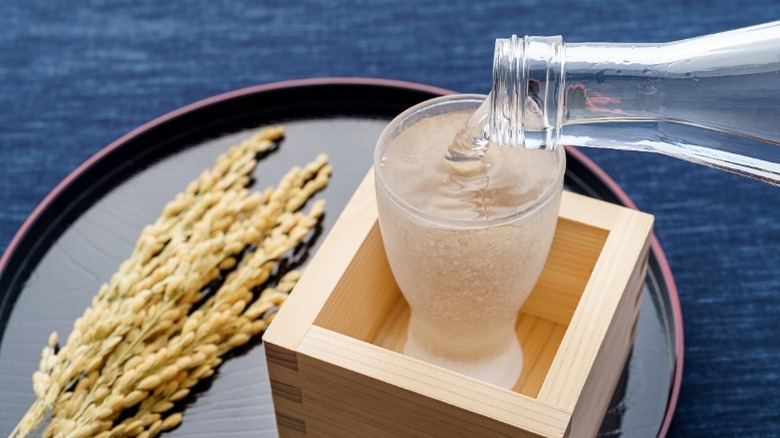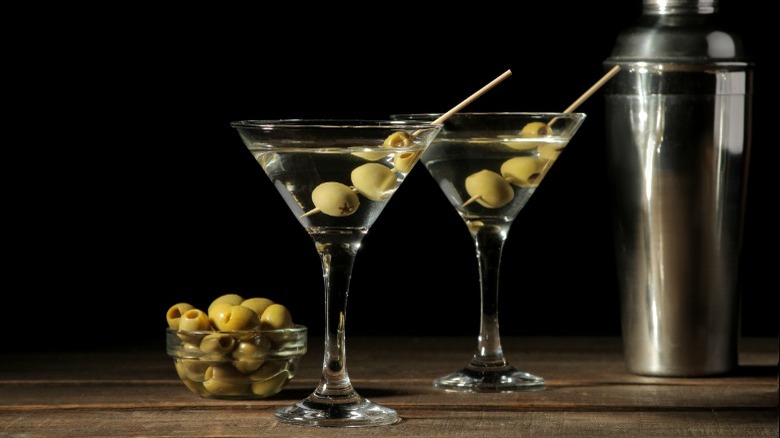Mix Up Your Next Martini Night With Sake
The martini is a cocktail with a glamorous history — no one can really agree on its true origins, but author Ernest Hemingway adored the drink, and James Bond has famously sipped on a dry martini. The classic dry gin martini is simple to make; all you need is gin, vermouth, orange bitters, and a lemon twist. With so few ingredients, it's a good choice for a staple drink. But, if you're thinking about mixing up your next martini night, sake could be a great new addition.
The "saketini" is a trendy twist on the classic martini, and incorporates the Japanese spirit into the celebrated V-shaped glass. You'll still want to keep the base for a saketini as traditional vodka or gin, and saketini recipes can vary regarding including vermouth. In those that do not, the sake takes on the role of the fortified wine. In recipes that still do have vermouth, the sake is a complement to the existing flavors.
Recipes also differ in the amounts of sake and gin or vodka used. Some have high ratios of sake to gin, like 8:1 or 6:1, but others have ratios like 5:2 (aka, 2.5 ounces of sake, and 1 ounce of gin). As a garnish, Japanese cucumber is one option, but you can also stick to olives or experiment with maraschino cherries or lychee, the latter two being great ways to add some sweetness to the drink.
What kind of sake will work best?
Sake comes in a number of different varieties. Each has its own unique flavor and recommended pairings, and there are certain kinds that could work better in a saketini than others.
Sake is made from rice, but the rice has to be stripped of its outer layer before it can be used in the brewing process. Based on how much the rice has been milled, the sake is assigned a grade. The lowest grade is Futsushu, which means less than 30% of the grain of rice is removed before brewing. As the rice becomes more milled, the grade of the sake increases. Honjozo means the rice has 30-40% of its grain removed, Ginjo is over 40% milled, and Daiginjo is over 50% milled. Additionally, there are terms that refer to how the sake itself is made. For example, Junmai sake is produced without any added alcohol, using only rice, water, and koji.
In terms of the best kinds of sake to use for a saketini, the answer requires a bit of thought. For example, you may want to enjoy your drink chilled, but many types of Junmai sake are actually best served warm. For cocktails, you can forgo using higher-quality sake varieties like Junmai or Daiginjo because they tend to have subtle flavor profiles, and they may be under appreciated in a saketini. For a fresh and bold flavor, the "nama" sakes (aka unpasteurized varieties) are best to use in cocktails.
Add a sake-friendly snack too
What's a martini night among friends without little snacks to nibble on? Thankfully, with sake — and the saketini — there are a number of food pairings that will elevate the drinking experience. While the beverage hails from Japan, another cuisine it pairs well with is Mediterranean dishes. The seafood and citrus notes in coastal Mediterranean foods complement sake well. That means that olives, a traditional martini ingredient, can also be more than a garnish, but also the perfect thing to snack on with a saketini in hand.
If you're a fan of cheese or other fatty foods, sake is the perfect companion for both of those, too. Because the spirit is light and acidic, it counters fatty or fried foods. The best kinds of cheese to pair with sake are semi-hard options like pecorino, manchego, gruyere, gorgonzola, or creamy varieties. Finally, don't be afraid to bring spice into the conversation when picking the perfect snacks to pair with your drink. Sake amplifies these flavors and goes particularly well with South American or Mexican seasonings, and surprisingly, American barbecue flavors as well.



